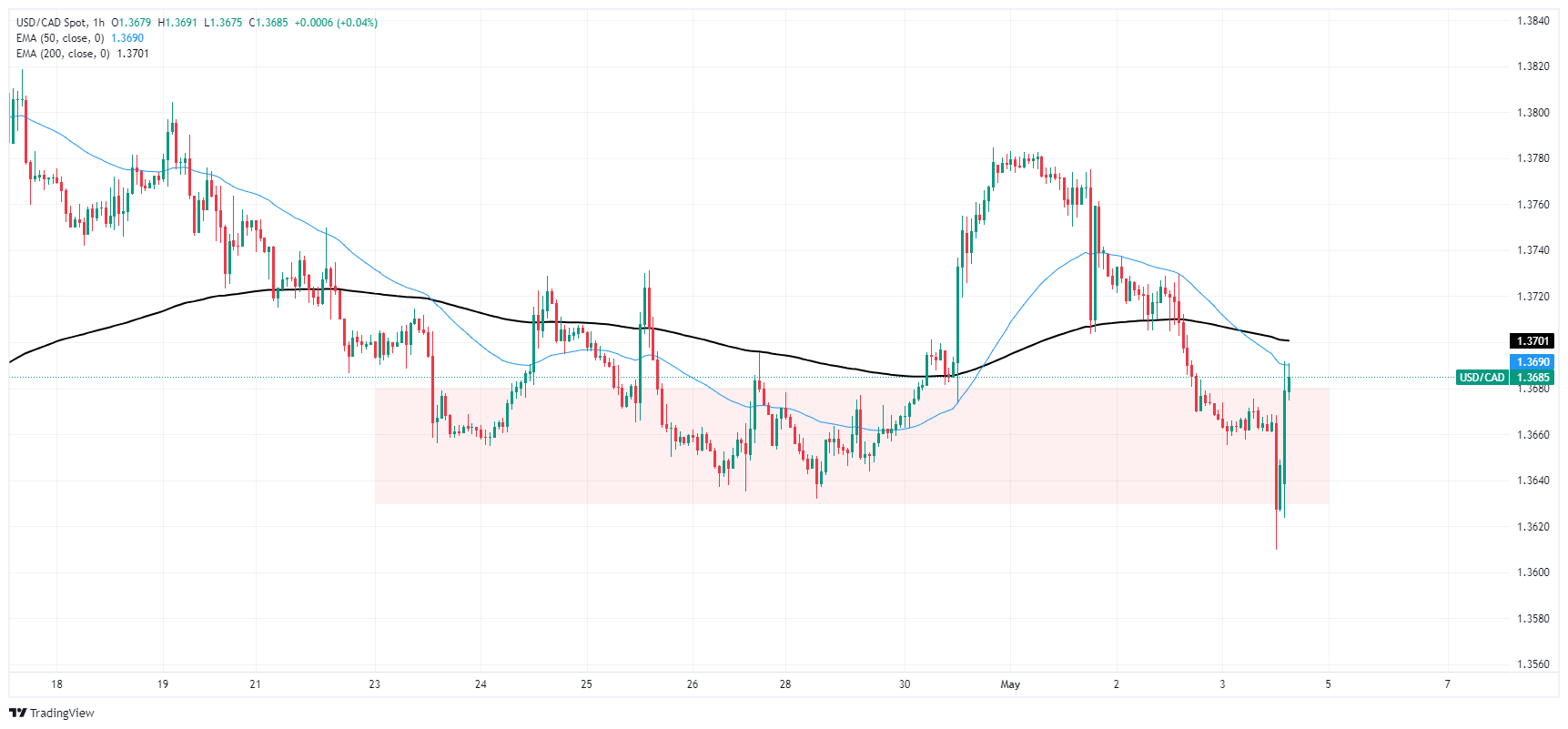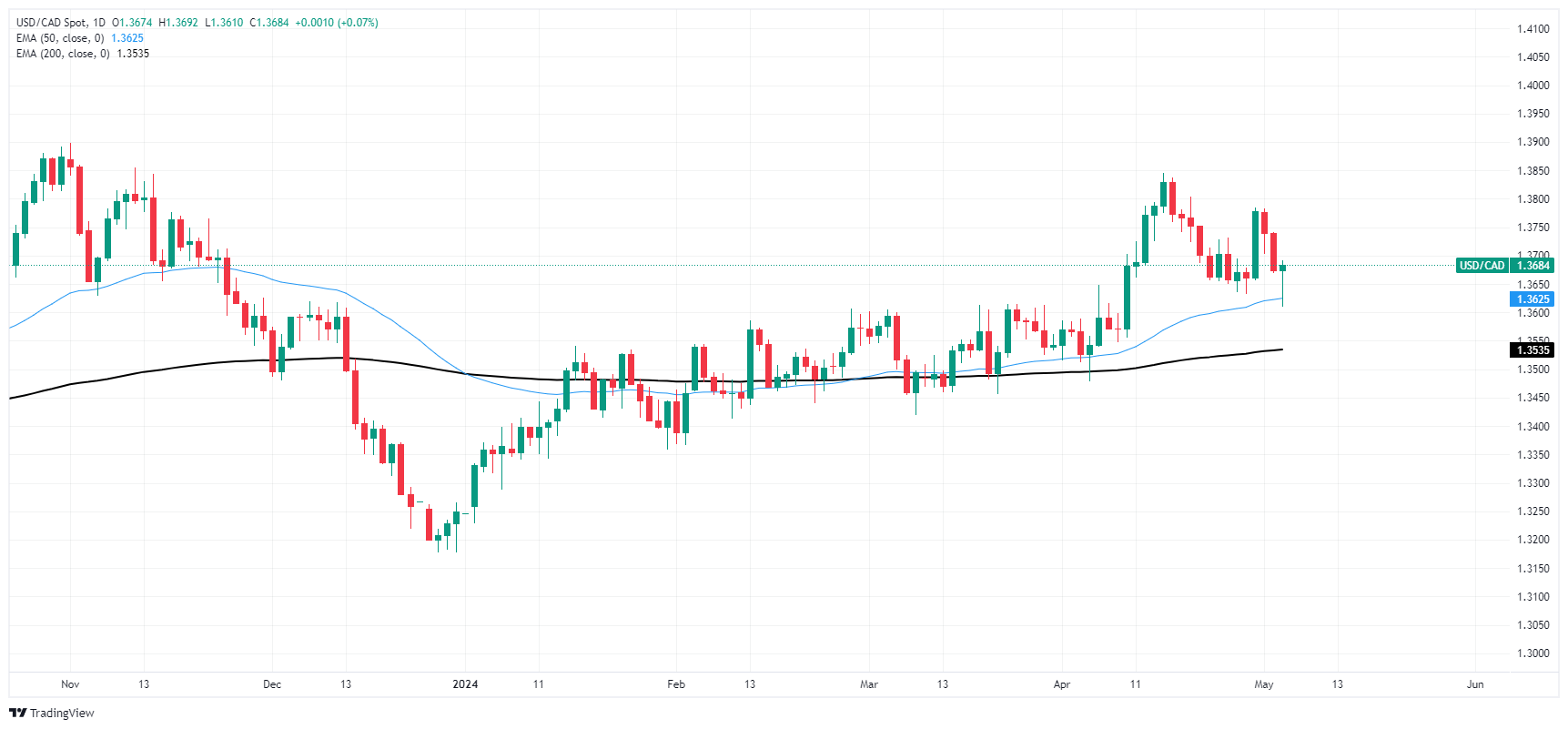- The Canadian dollar suffers a general fall on Friday.
- Canada will resume its economic calendar next Tuesday.
- US data is generally disappointing, especially in terms of employment growth.
The Canadian Dollar (CAD) fell across the board on Friday after U.S. Non-Farm Payrolls (NFP) and wage data largely missed forecasts, sending the Canadian currency lower after the initial impulse. The US Services Purchasing Managers' Index (PMI) also fell back into contraction territory for the first time since January 2023.
Canada has no significant economic data until next Tuesday with the Ivey PMIs, leaving the Canadian Dollar at the mercy of the broader markets on Friday. With poor US data dragging down investor appetite for the Canadian Dollar, the CAD is being battered, falling against all of its major currencies. Crude oil prices also weaken on Friday, dragging the CAD further lower.
Daily Market Moves Summary: US NFP Fails, Rising Inflation Hits CAD
- US NFP shows a net employment increase of 175,000 in April, below the forecast of 243,000. The previous month saw an upward revision to the forecast. The previous month was revised upwards and went from 303,000 to 315,000.
- Average hourly earnings also grew 0.2% month-over-month in April, below the forecast of 0.3%.
- The US unemployment rate also rose to 3.9% from 3.8% previously.
- The US ISM services PMI unexpectedly fell below the contraction level of 50.0 for the first time in more than a year, falling to 49.4 as market forecasts pointed to a slight rise to 52.0 from 51.4 the previous month.
- The ISM for services at prices paid accelerated to 59.2 from 53.4, keeping inflationary fears on the surface.
Price of the Canadian Dollar today
Below is the percentage change of the Canadian Dollar (CAD) against the main currencies listed today. The Canadian dollar was the weakest currency against the New Zealand dollar.
| USD | EUR | GBP | CAD | AUD | JPY | NZD | CHF | |
| USD | -0.33% | -0.05% | 0.09% | -0.62% | -0.16% | -0.84% | -0.59% | |
| EUR | 0.34% | 0.30% | 0.43% | -0.27% | 0.21% | -0.48% | -0.24% | |
| GBP | 0.04% | -0.29% | 0.14% | -0.57% | -0.11% | -0.79% | -0.51% | |
| CAD | -0.09% | -0.43% | -0.11% | -0.68% | -0.24% | -0.92% | -0.65% | |
| AUD | 0.62% | 0.27% | 0.57% | 0.70% | 0.47% | -0.21% | 0.03% | |
| JPY | 0.15% | -0.19% | 0.10% | 0.21% | -0.47% | -0.66% | -0.44% | |
| NZD | 0.82% | 0.47% | 0.78% | 0.92% | 0.22% | 0.67% | 0.25% | |
| CHF | 0.57% | 0.24% | 0.52% | 0.65% | -0.05% | 0.43% | -0.27% |
The heat map shows the percentage changes of the major currencies against each other. The base currency is chosen in the left column, while the quote currency is chosen in the top row. For example, if you choose the Euro in the left column and scroll down the horizontal line to the Japanese Yen, the percentage change that appears in the box will represent EUR (base)/JPY (quote).
Technical analysis: Canadian dollar weakens on Friday amid investor disinterest
The Canadian Dollar (CAD) fell overall on Friday, losing about a tenth against the US Dollar (USD) despite a bullish start to the day. The New Zealand Dollar (NZD) recovered in the market and the CAD lost one percentage point against the Antipodean currency, while the Australian Dollar (AUD) lost an additional eighth. The CAD also falls by around half a percentage point against the Euro (EUR).
The USD/CAD pair rebounded to the upper end of a recent demand zone between 1.3680 and 1.3630 after a rapid decline on Friday morning to 1.3610. The pair's decline did not last long and bids returned to the demand zone near 1.3700.
USD/CAD hourly chart
USD/CAD daily chart
Frequently Asked Questions about the Canadian Dollar
The key factors that determine the price of the Canadian Dollar (CAD) are the level of interest rates set by the Bank of Canada (BoC), the price of Oil, Canada's main export product, the health of its economy, the inflation and the trade balance, which is the difference between the value of Canadian exports and its imports. Other factors are market sentiment, that is, whether investors bet on riskier assets (risk-on) or look for safe havens (risk-off), with the risk-on being positive for the CAD. As Canada's largest trading partner, the health of the US economy is also a key factor influencing the Canadian dollar.
The Bank of Canada (BoC) exerts significant influence over the Canadian Dollar by setting the level of interest rates that banks can lend to each other. This influences the level of interest rates for everyone. The BoC's main objective is to keep inflation between 1% and 3% by adjusting interest rates up or down. Relatively higher interest rates are usually positive for the CAD. The Bank of Canada can also use quantitative easing and tightening to influence credit conditions, with the first being negative for the CAD and the second being positive for the CAD.
The price of oil is a key factor influencing the value of the Canadian Dollar. Oil is Canada's main export, so the price of oil tends to have an immediate impact on the value of the CAD. Generally, if the price of oil rises, the CAD also rises, as aggregate demand for the currency increases. The opposite occurs if the price of oil falls. Higher oil prices also tend to lead to a higher probability of a positive trade balance, which is also supportive for the CAD.
Although inflation has traditionally always been considered a negative factor for a currency, since it reduces the value of money, the truth is that in modern times the opposite has happened with the relaxation of cross-border capital controls. Rising inflation often leads central banks to raise interest rates, attracting more capital inflows from global investors looking for a lucrative place to store their money. This increases the demand for the local currency, which in the case of Canada is the Canadian Dollar.
The macroeconomic data that is released measures the health of the economy and can influence the Canadian dollar. Indicators such as GDP, manufacturing and services PMIs, employment and consumer sentiment surveys can influence the direction of the CAD. A strong economy is good for the Canadian dollar. Not only does it attract more foreign investment, but it may encourage the Bank of Canada to raise interest rates, resulting in a stronger currency. However, if economic data is weak, the CAD is likely to fall.
Source: Fx Street
I am Joshua Winder, a senior-level journalist and editor at World Stock Market. I specialize in covering news related to the stock market and economic trends. With more than 8 years of experience in this field, I have become an expert in financial reporting.





